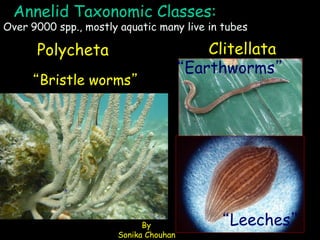
Annelida
- 1. Annelid Taxonomic Classes: Polycheta “Earthworms” “Leeches” “Bristle worms” Clitellata Over 9000 spp., mostly aquatic many live in tubes By Sonika Chouhan
- 2. Annelid Taxonomic Groups: Previously considered sepearate phyla “ Echiura PogonophoraSipuncula
- 3. I. General Characteristics II.Class Polychaeta A. Basic Body Plan, Swimming, Reproduction and Development B. Polychaete Adaptive radiation III. Other Marine Annelids (derived polychaetes) A. Family Siboglinida : Vent worms and whale worms B. Echiura and Sipuncula IV. Class Clitellata A. Oligochaetes B. Hirudinea Annelida
- 4. Despite apparent differences the polychaetes and oligochetes share fundamental features Segmented body Metamerism Hydrostatic skeleton by a true coelom Complete digestive tract Closed circulatory system polychete oligochete Leeches along with oligochetes; both are in the Class Clitellata Clitellum Coccoon No parapodia No head appendages
- 5. Class Polychaeta: marine bristle worms Prototype Errant (crawling-type) Nereis (Fig 15.4) Metameric condition Prostomium peristomium segment
- 6. Parapodia Setae or Chetae (made of chitin) acicula Circulatory system Fig 15.1-3 Parapodia capillaries ganglia nephridia
- 7. The excretory system consists of metanephridia that work by selective transport (fig 15.2) Urine
- 8. Types of Skeletons in Animals Endoskeleton Exoskeleton Hydrostatic skeleton In what ways are these three types of skeletons functionally similar?
- 10. Polychete Reproduction: Gametes form from cells that line the coelom Some copulate but most form Epitokes Odontosyllis enopla In Fiji and Samoa, palolo worms swarm on the 7th night after the full moon that follows the autumnal equinox!! (October usually….) (Fig 17)
- 11. • Hierarchical System of Controls - Day length cues seasonal reproduction – Lunar Cycles synchronize local spawning events - Meteorological phenomena are likely the final trigger to epitoky - Complex Sex Pheromones synchronize nuptual dance and spawning
- 12. Polychete Reproduction Is the trochophore a plesiomorphic (ancestral) character shared by molluscs, annelids and related phyla?
- 13. Metameric body plan of Nereis and of other errants is the “basic” condition fireworm • Head prominent • Crawling parapods • Eversible pharynx some spp. with poison glands.
- 14. Swimming Polychete: Tomopteris • Large parapods • Transparent body • Enormous eyes • Active predators Swim with paddle-like parapodia or for rapid swimming by increasingly rapid undulations of the body combined with parapodia
- 15. Burrowing Polychaete: • Move by peristalsis • Head streamlined • Parapods reduced • Deposit Feeders “earthworm-like”
- 16. tube dwellers Feather duster Xmas tree Fan worms etc. --Tubes of Mucus Sand Parchment Calcite
- 17. •Movement limited •Head reduced but with tentacles •Parapods small •Passive and Active suspension feeders •Filter Feeders tube dwellers
- 18. Most specialized Tube dweller is Chaetopterus
- 19. Marine annelid diversity Specialized Taxa
- 20. Annelid Diversity: “ Class Echiura Polychaeta Family SiboglinidaeSubFamily Vestimentifera SubFamily Frenulata Genus Osedax
- 21. Annelid Family Siboglinidae “... small but very intriguing group…” • Live deep in the ocean • No digestive system • Thrive in areas of high methane or sulfur Includes Frenulate “spaghetti worms” that feed by absorbing nutrients Whale carcass worms: root system absorbs bacterial nourishment from bone marrow; & symbiotic bacteria Vestimentiferan giant cold seep and hot vent worms
- 22. < 1mm diameter 10 - 74 cm long (spaghetti-like worms) Fig 13.12-13.14 Sub Family Frenulata 6-25 segments containing coelomic compartments that are isolated from each other by muscular septa; each segment bears chitinous setae opisthosoma
- 23. Sub Family Vestimentifera Large thick bodies, up to 2 m long vestimentum
- 24. Whale fall time series Hagfish Sleeper sharks Polychaete worms (free living, bacterial grazers) Vigtorniella (Polychete) Whale carcass worms Osedax not considered Vestimentiferans
- 25. A watercolor painting shows females and males from the new marine worm species. The female worms are illustrated both in their tubes and with a whalebone “cutaway,” to reveal their large ovisacs and extensive roots that invade the bone. The small males live in the tubes of the females and are shown as “blowups” with their relative positions in the tubes indicated by the dark lines. Top left: male Osedax rubiplumus. Top right: female Osedax rubiplumus. Bottom left: male Osedax frankpressi. Bottom right: female Osedax frankpressi.
- 26. F. Siboglinidae Vestimentiferans vent worm Riftia Fig 13.15-16 V blood vessel plume heart trophosome tube
- 27. …deep-sea hydrothermal vents may help advance the understanding of how early microbial life forms gained a foothold in hydrothermal systems on early Earth and potentially on other planetary bodies. (McCliment et al., 2005, Environmental Microbiology 8: 114-125) Microbiologically analogous to Archean vent systems and may serve as models for the origin and evolution of life in Archean vents. Baross ad Hoffman (1985) in Origins of Life and Evolution of Biospheres An alternative proposal to the “pre-biotic soup” theory…chemical conversions that involve “transition metal sulphide catalysts” create favorable environments for abiogenic acetate production that release energy… acetyl-coA is the most central carbon backbone in microbial metabolism Martin et al., 2008, Nature Reviews 6: 804-14 Read Research Focus 13.1 on Chemosynthesis
- 28. The Newest Annelids Sipuncula Annelids (peanut worms) Echiura (inn keeper worms)
- 29. - Fewer than 600 species; found primarily in shallow marine habitats; deposit/detritus feeders - Soft bodied, with very poor fossil record, but with distinctly protostomous embryological characters - Best known for having teleplanic larvae The Sipuncula:
- 30. The Sipuncula Ecologically and functionally like Echiura Instead of a proboscis a fully retractable head region known (introvert) aids feeding
- 31. Muco-ciliary deposit feeders Live in sand, mud, crevices With scoop-shaped proboscis Main body is large coelom The Echiura
- 32. “Fat inkeeper” worm is best known representative
- 34. Thank you
